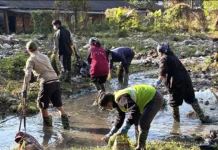Flights Of Fantasy
[ M Panging Pao ]
Monsoon rains have exposed the poor quality and poor planning of various infrastructures like roads, bridges, electricity, etc. From the western areas of Kameng and Bameng, through Subansiri and Siang in central Arunachal, to the southern areas of Namsai, Tirap and Changlang, there were floods, landslides and mudslides, leading to road blockages.
Many roads to remote areas were cut off, resulting in marooned citizens and ration shortages in the remote villages. In some cases, mudslides and floods led to the loss of precious lives. The rains have converted the roads in the capital complex into a muddy, slippery mess. Even the recently constructed Yupia-Hoj-Potin road is in a dilapidated condition.
While constructing highways and roads in the state, it seems that earth-cutting, drainage, and adequate protection have not been planned and executed with foresight. This has led to the loosening of the hillsides, leading to landslides and mudslides. In addition to causing road blockages, these landslides and mudslides have resulted in loss of homes and properties. Many common Arunachalees have also contributed to mudslides and landslides by rampant earth-cutting for creating infrastructure without proper studies and analyses.
Many roads, electric lines and towers, mobile towers, bridges, etc, break down even in mild weather phenomena like rains, windy conditions, local storms, etc. Collapse of essential infrastructure in mild weather indicates poor quality and workmanship. During emergency situations like natural calamities, vital infrastructures like roads, railways, bridges, hospitals, airports, electricity and mobile towers, would be required for rescue and relief operations. Availability of these critical infrastructures will save many lives during natural calamities. Therefore these critical infrastructures need to be treated as the last line of defence and needs to be planned and constructed well.
Poor quality of infrastructure results from acceptance of substandard work due to leakages of funds and due to the ‘chalta hai’ attitude. Natural calamities occur all over India and in other parts of the world. But critical infrastructure does not fail easily, and even if they fail, they are repaired in quick time. Quick recovery and repairs of critical infrastructures ensure that normal life resumes at the earliest.
During the ongoing monsoon season, many remote areas were cut off due to roads and bridges getting washed away and electric towers and lines collapsing at many places. Even the newly constructed 132 kva power transmission line collapsed, leading to power outages in central and eastern Arunachal. We need to learn from these incidents and prepare alternative roads to connect our towns. We also need to carry out an audit of all vulnerable areas and find lasting solutions.
The true test of quality is when infrastructures like roads, bridges, towers and electricity lines stand up during bad weather conditions. Has poor quality become a part and parcel of our lives? Are the common citizens supposed to suffer silently without complaining? What might happen if an actual cyclone or earthquake hits us? (The contributor is retired Group Captain, Indian Air Force)


